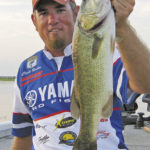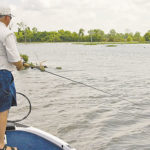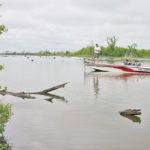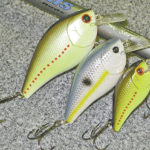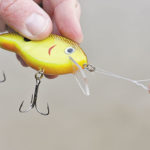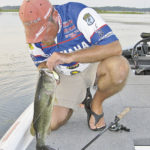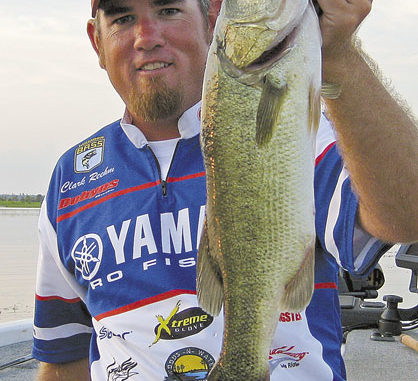
Leave the spinnerbaits and round-billed crankbaits in the box this month if you’re fishing wood on the Red River.
Bass anglers old enough to remember Huey Lewis’ hit single, “It’s Hip To Be Square” from 1986 probably didn’t realize just how much awesome advice was encapsulated in those lyrics.
The song was about a renegade fellow that used to fool around and party too much before coming to the realization that he had to settle down, cut his hair and start being responsible simply because everybody else was doing it.
At face value, the message seems to be that this one-time rebel either finally grew up enough to put his undisciplined youth to rest, or he was trying so hard to be different that he actually wound up just like everybody else.
Shoot, now that I think about it, I actually see two bass-fishing lessons in these lyrics. The first is that it’s cool to throw square-billed crankbaits, and the second is that if you’re not throwing square-billed crankbait because everybody else is throwing them and you want to be different, it’s high time you put your misguided rebellion to rest.
“The simple fact is if we’re both in a tournament on the Red River, and I’m throwing a square-bill and you’re not, I’m gonna take your money,” said BASSMASTER Elite Series professional angler Clark Reehm. “People get so hung up on throwing spinnerbaits and the 200 Series Bandits, but when the pros come to town, most of them are going to have a square-bill tied on.”
Reehm has taken enough money on the Red River to back it up, too. Within just a few short years, this Louisiana Tech graduate and former Fort Polk civilian employee finished second in a Wal-Mart BFL tournament, and he finished sixth and 10th in two of the most recent BASSMASTER Central Open tournaments held on the Red River.
“The simple fact is that square-billed crankbaits come through rock and wood cover better than round bills,” said the former BASSMASTER Classic qualifier. “And the Red River is essentially just one great big old wood pile.”
Another angler who is hung up on throwing square-bills on the Red River is Simsboro resident Sid Havard. He is a perfect example of a local angler who was exposed to square-bills by a professional angler.
BASS pro Scott Rook was fishing with Havard a few years ago in preparation for a tournament, and Havard says it didn’t take long to realize that the square-bills were the way to go on the Red.
“Man, he sacked them on me,” Havard recalled. “I didn’t know anything about them at the time, but he showed me that they are the real deal in thick wood. He made his crankbaits bank into and jump over all that wood, and that’s when they ate it.”
It is the design of square-billed crankbaits that allows them to bang off of rather than dig into wood cover. Many of the bills on most popular models today are actually more of a trapezoid than they are a square. In other words, they are wider at the end of the lip than they are where the lip meets the bait.
Each corner is a sharply tuned angle, and it is those angular corners that cause a square-billed crankbait to deflect off of solid wood cover. When these square corners hit an obstruction, the bait is actually turned on its side, and the hooks flare upward. As the bait rights itself and resumes its normal path, bass attack it.
Reehm believes a square-bill is the lure anglers should reach for first when they think bass are seeing too many spinnerbaits. How many chartreuse/white 1/4-ounce spinnerbaits do you think Red River bass have seen during their lifespans? That’s why he’s adamant about showing them something different.
“I don’t care if I get hung up,” he said. “I throw the Lucky Craft RC models, and they’re $15 crankbaits. I still don’t care because you’ve got to put this kind of bait in places where the fish are used to seeing only spinnerbaits. Rather than showing bass another flashing blade, I want to show them a big wide-body wobbling bait coming through that same spinnerbait zone.”
What, then, is the perfect spinnerbait zone? According to Reehm and Havard, the perfect spot is what they both called “the 45s.” These are trees or logs that have fallen into the water at a 45-degree angle. Unlike pole timber that allow bass to move only vertically, trees lying at a 45-degree angle allow bass to reposition horizontally as well as vertically. They also provide the perfect ambush zones for big bass.
“A lot of people recommend throwing parallel to those kinds of trees,” said Havard. “That’s good, but for me, the best retrieve has been perpendicular to the tree and reel it right across that spot right where the tree enters the water. I try to make my bait actually jump over the log.”
Although many anglers have probably bounced a crankbait off a log or two, Reehm says that professional anglers understand that it takes more than that to trigger a reaction strike from an inactive bass. That’s why he “cranks the snot out of it.”
“Baits like the Lucky Craft RC series are designed to be reeled fast,” he explained. “In fact, if you reel them slow, you won’t get quite the same kind of wobble as you get when you’re really cranking them in. A lot of anglers throw crankbaits on a 5:1-gear-ratio reel, but that’s too slow for a square-bill.”
Reehm selects a high-speed reel so he can really crank his baits in fast, which accomplishes two things other than getting the right wobble. First, it allows him to quickly cover a lot of water to locate groups of bass and pick off isolated fish. Second, it allows him to really crash his baits into the wood in such a way to make them violently carom off.
Color doesn’t seem to matter much to either angler, and they pride themselves on keeping it basic enough so as not to confuse themselves while they’re on the water. Reehm selects chartreuse/black for most applications in stained water and purple/white in areas where the water is clear enough to see the bottom.
“Sometimes people put too much thought into color without thinking that the color they see on a crankbait isn’t what it’s going to look like to bass under water,” said Reehm. “Chartreuse/black is a good representation of what most bass in the Red River are used to eating — things like bluegill and shad.”
Although many areas of the Red River are no longer the maze of stumps, timber and logs that they used to be because a lot of that stuff has rotted out, there are a few areas in Pool 4 that are known for being hot square-bill spots.
Reehm pointed out backwaters like the Goose Pond and the Jungle, and Havard mentioned Sullivan’s and Red Oak as being two of his favorite places. While these have been productive areas in the past, Havard added that the location really doesn’t matter. As long as you can see some logs, stumps or laydowns, you can catch fish on the square-bills.
“And October is a killer month to get out there and try it,” Havard said. “With the water cooling off and bass feeding on shad, which the river is loaded with by the way, it all adds up to throwing square-bills.”
“Don’t forget about throwing them on the rocks,” Reehm interjected. “On the main river, I love paralleling the rocks with the Lucky Craft RC 1.5. The trick is to make it kick off those rocks just like you do the timber in the backwaters. Just remember that if you’re getting a lot of that black slime on it each time you reel it in, move out deeper until you get out of that stuff.”
Professional anglers like Reehm know what a square-billed crankbait is capable of doing on the Red River, and locals like Havard are pushing aside their round-billed crankbaits in favor of trying to fit in to what they see going on around them.
There’s a time and place to rebel, but that time is not the Red River during October. This is the month that it’s OK to be square and OK to try to be like everybody else. Don’t worry about people making fun of you for being aware of and influenced by this latest trend because they’ll understand when they see your huge sack of bass that’s it is hip to be square.
